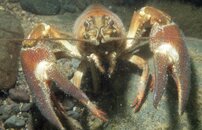I’ve been diving rivers all my life (many decades). Here are a couple of YouTube videos which will describe some of my diving.
From a safety perspective, I dive a float, and always carry my dive knife (BFK) on my leg sheath. Any cutting tool has to be immediately accessible, because of the hazard of fishing line, which is almost invisible underwater. Current is best handled by diving to the bottom, where it is not as bad. I dive smaller rivers, which have the shore immediately available.
And, I see things most others never would see. Here’s another video, quite long, but showing how I handle river diving. I was documenting the spawning habits of the lampreys that inhabit the Pacific Northwest rivers.
SeaRat
From a safety perspective, I dive a float, and always carry my dive knife (BFK) on my leg sheath. Any cutting tool has to be immediately accessible, because of the hazard of fishing line, which is almost invisible underwater. Current is best handled by diving to the bottom, where it is not as bad. I dive smaller rivers, which have the shore immediately available.
And, I see things most others never would see. Here’s another video, quite long, but showing how I handle river diving. I was documenting the spawning habits of the lampreys that inhabit the Pacific Northwest rivers.
SeaRat







